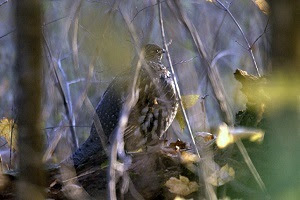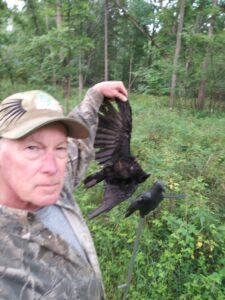Crows: They’re not Just for Breakfast Anymore
By Glen Wunderlich
Outdoor Columnist
Professional Outdoor Media Association
In case you haven’t noticed, crow hunting season is in full swing. If you missed the action so far, you have until the end of September to become crow-active. Many people consider this member of the Corvidae family to be a varmint, while others respect and revere them for their intelligence. However you choose to view them, it has become apparent that they are especially susceptible to West Nile Virus (WNV) infection, with crows and blue jays (another corvid member) accounting for between 50 and 90 percent of avian cases. It’s no wonder they have become the focus of surveillance efforts across North America. With innocent human life at stake through transmission of WNV from corvids to people, it confounds me that crows are protected 8 months out of the year.
It all started with the initial signing of an official Migratory Bird Treaty in 1936 between the United States and Mexico. Growing concerns about the status of endangered migratory birds, such as the spotted owl, got us started in this predicament of protection of a bird that really doesn’t migrate. Our government realized that birds flying from Central and South America to North America ran the gauntlet of hungry sustenance peasant hunters in search of their next meal. U.S. officials worried about possible extinction of certain birds and thus the treaty was signed February 7, 1936 in Mexico City and remains in effect today.
Article 1 of the US-Mexico Bird Migration Treaty (MIGRATE), allows both countries the utilization of the birds for the “purposes of sport, food, commerce and industry.” Article II places limitations relative to hunting seasons, which made it illegal to hunt birds past a certain point in the year. Article III regulates transportation of the birds – dead or alive – and requires a permit by both countries to be legal. Article IV states and names all bird species that are considered migratory, while 23 species are considered non-game birds, such as cranes and rails. So far, it seems to make sense, but here’s where it gets wacky.
Under article IV, there is an “Other” category, in which other species may be added to the list, if both parties agree. In 1972 the inexplicable happened: The Crow family was added to the list. So, in the stroke of the pen, crows went from vermin to vagary and remain conditionally protected today. In Michigan, where a fair number of these “migrating” masters of mischief seem to spend their winters, we can hunt them from February 1st through March 31st. The season also ran from August 1st through September 30th last year, but I am not going out on a limb, so to speak, to state it will be the same this year. However, crows may be taken outside of the open season during hunting hours, in compliance with federal regulations, if these birds are causing a nuisance or creating a health hazard. That would indicate to a normal thinking person that they’d be fair game any time. They “caws” trouble just about any time they are out of the nest and can be a health hazard from biting mosquitoes passing on WNV disease during our lengthy mosquito season. Ah, but it’s not that easy.
As part of MIGRATE, Federal Regulation 50 CFR part 21.43, crows may be taken under certain depredation situations. It states one doesn’t need a Federal permit (you gotta be kidding!), when crows are found committing or about to commit certain depredation upon ornamental or shade trees, agricultural crops, livestock, or wildlife or when they are concentrated in such numbers as to constitute a health hazard or other nuisance. But, don’t let the G-men catch you with any decoys, calls, or other devices to entice birds within gun range, because they are specifically prohibited under the depredation order by Section 21.41 (c). The U.S. Fish and Wildlife Service (USFWS) figures the basis for these restrictions is that it would be counterproductive to lure or entice crows into an area already experiencing depredation problems.
I realize most people don’t set out to eat crow, but they end up doing it involuntarily – sometimes even with foot in mouth. I have heard that 4 and 20 blackbirds are sufficient for one good-sized pie, but take note that the DNR advises to wear rubber or latex gloves when handling and cleaning dead animals. Tools used when processing birds should be disinfected after use with bleach (10% solution) and washed in soapy water. Consuming the meat of an infected bird has infected no humans to date. (Well, that’s something to crow about!) However, the meat of birds should be cooked thoroughly. Heating to an internal temperature of 170 to 180 degrees Fahrenheit will kill West Nile Virus as well as other bacteria, eliminating the risk of infection. Gotta run now. Got some crow-quettes on the grill.







